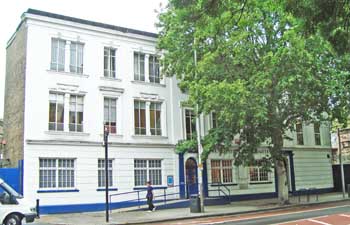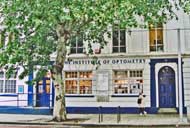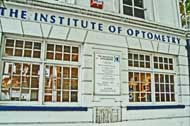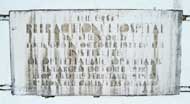Specialist. Out-Patients only
After several years' deliberation, the London Refraction Hospital was founded in October 1922 by the Institute of Ophthalmic Opticians. Owen Aves, one of the 'grand old men' of optics in the early 20th century, was one of the co-founders. (He had patented the first progressive addition lens in 1907, but multifocal lenses were not produced commercially until the 1950s).
The Hospital opened in No. 58 Newington Causeway. It provided a complete range of optometric services, especially for the poor, and was a clinical training centre for optometry students and practitioners. In its first year, some 748 patients were treated. Who was Annie Zunz?By 1927 the number had risen to 4,870.
In 1927 Glaswegian optometrists stated their intention to set up a similar institution, since some 400 qualified opticians from Scotland had attended the courses run by the Hospital. This provoked a letter to the British Medical Journal, fulminating about the use of the word 'Hospital', as the London Refraction Hospital was merely "a meeting place for opticians to collect a few patients, examine their eyes according to their capacity, and instruct their neophytes in their methods". By calling the place a 'Hospital', their students could claim to be 'hospital-trained'. The writer also objected to the "profuse use of high-sounding titles", such as 'optologist', 'ophthalmologist' and 'qualified ophthalmic optician'. The Hospital Secretary responded, refuting the arguments and stating that the word 'Hospital' was defined as "a building ... for the benefit of any class of persons requiring public help".
In 1928 No. 60 was acquired, and the Hospital closed so that the buildings could be remodelled, at a cost of £10,000). One of the jewels of the Hospital was its Orthoptic Clinic, the first in the country, providing non-operative treatment for squint.
The enlarged Hospital was officially reopened by the Countess of Mayo in February 1929, and a wooden plaque was put up inside the building to commemorate this. A bronze plaque was also put up in memory of Owen Aves, who had been instrumental in the development of optical education and who had died in 1929, along with a plaque for Dr James Forrest, who had taught optometry students about ocular disease.
In 1929 the Hospital treated 6,836 patients.
In 1935 the Hospital bought another adjacent house, No. 62.
By 1936 the Institute of Ophthalmic Opticians was feeling the financial strain of running the Hospital. The bulk of its income came from collecting boxes in opticians' surgeries, which might yield up to £10 a year each, but only 10% of opticians had these boxes. The Institute approached the British Optical Association for support, with the outcome that the Hospital was sold to the Association. In 1938 the Association presented the Hospital to the Charity Commission, who produced a scheme to operate it as a free-standing charity.
During WW2 the Hospital was badly damaged by bombing in 1943, and its Orthoptic Clinic completely destroyed. By this time some 100,000 patients had been treated since the Hospital opened in 1922, while staff had given 60,000 hours of voluntary time. The backbone of the Hospital appears to have been the Matron, Mrs S. Crawley, nicknamed 'Mother Crawley'. Described as the 'oldest inhabitant', she had ruled with a rod of iron from the beginning.
The Hospital managed to keep functioning to some degree in the ruined buildings, while trying to raise £10,000 to rebuild.
In 1947 a Contact Lens Research Group was
established. The members of the Group experimented on each
other's eyes, using the dental material Zelex to take impressions of
the eyeball for the fitting of contact lenses. Another moulding
material used to make a moulding shell cast of the eyeball was Negacoll,
By 1949 the Hospital had been repaired and re-equipped.
In 1988 the Hospital was renamed the Institute of Optometry. Its role expanded to include postgraduate training and education, and research.
In 2008 the Institute launched a new degree, a Doctorate in Optometry, in collaboration with the London South Bank University, for part-time study by qualified optometrists.
Present status (July 2010)
The Institute of Optometry remains an independent self-financing charity. It promotes clinical excellence, research and education in optometry.

The Institute of Optometry.


The main entrances to the building (left). A commemorative plaque giving a short history of the London Refraction Hospital is located between the main windows (right).

The plaque states that this was the first Refraction Hospital in the world. It was placed there following the rebuilding and enlargement of the Hospital in 1929.
(Author unstated) 1949 Practice of orthoptics. Views of BOA. British Medical Journal 2 (4624), S95.
Bishop Harman N 1927 Refraction "Hospital". British Medical Journal 2 (3486), 806.
Gregg FT 1927 Refraction "Hospital". British Medical Journal 2 (3489), 959.
Hardy WE, Hogg AE 1943 The London Refraction Hospital - Its History and Work - 1922-1943. London, Borough Press.
http://blog.modernmechanix.com
http://en.wikipedia.org.uk
www.college-optometrists.org
www.ioo.org.uk
Return to home page